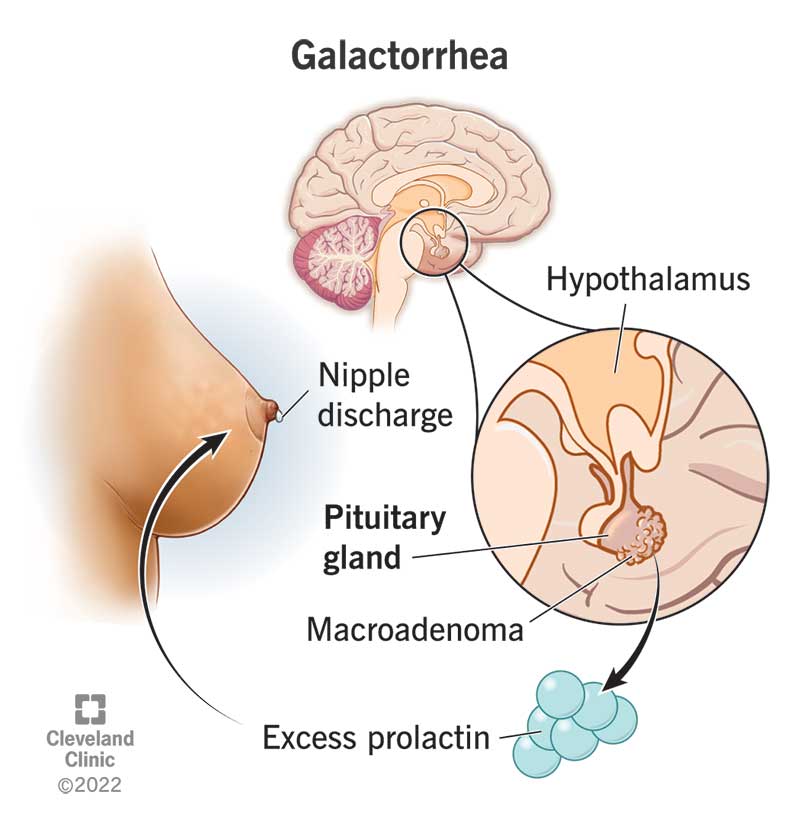Galactorrhea is a condition where your breasts leak milk. The main sign of galactorrhea is when it happens in people who aren’t pregnant or breastfeeding. It’s caused by stimulation, medication or a pituitary gland disorder.
Advertisement
Cleveland Clinic is a non-profit academic medical center. Advertising on our site helps support our mission. We do not endorse non-Cleveland Clinic products or services. Policy

Galactorrhea (guh-lack-toe-REE-uh) happens when your breasts unexpectedly produce milk or a milk-like discharge. This nipple discharge may leak from your breast on its own or when touched. It’s not related to milk production in breastfeeding or pregnancy. Galactorrhea sometimes indicates an underlying health condition, but is most often caused by too much prolactin. Prolactin is a hormone that triggers milk production. It’s made by your pituitary gland, a gland at the base of your brain.
Advertisement
Cleveland Clinic is a non-profit academic medical center. Advertising on our site helps support our mission. We do not endorse non-Cleveland Clinic products or services. Policy
Galactorrhea occurs most often in women, but can also develop in men and children. It’s most common in people who are of reproductive age (between 20 and 35) and who have been pregnant.
Galactorrhea may affect up to 20% of women.
The most common cause of galactorrhea is a benign (not cancerous) tumor on your pituitary gland. The tumor causes your pituitary gland to make too much prolactin (hyperprolactinemia). Prolactin is the hormone responsible for milk production after you give birth. Excess prolactin tricks your body into thinking it should lactate (or make milk), which is why you leak milk from your nipples.
Other causes include:
The main symptom of galactorrhea is leaking a light white, milk-like discharge when you’re not breastfeeding or pregnant. It typically affects both breasts and may flow if you squeeze your nipple or leak on its own.
Advertisement
Other symptoms associated with galactorrhea may include:
Not usually. Galactorrhea is a highly treatable condition. If your galactorrhea is caused by a tumor on your pituitary gland, it’s typically a noncancerous tumor that responds well to treatment.
Galactorrhea doesn’t cause weight gain. However, excess prolactin and thyroid disorders are both associated with weight gain. If you’re gaining weight and have galactorrhea, it may be due to increased prolactin and irregular thyroid function.
The milk that leaks from your breasts when you have galactorrhea is considered milk because it’s produced by the same hormone (prolactin) that makes breastmilk in women who’ve just given birth.
Yes, but this is rare. It’s caused by estrogen crossing into your baby’s blood while they’re in your uterus. It usually resolves on its own shortly after birth; but you should let your child’s pediatrician know.
Yes, men can get galactorrhea. It’s sometimes seen in people with gynecomastia (enlarged breast tissue) or low testosterone (hypogonadism).
Healthcare providers diagnose galactorrhea through some of the following:
Treatment for galactorrhea varies depending on the cause of the condition. In some people, it goes away on its own without any treatment.
To manage the condition, your provider may also recommend:
In cases where a pituitary tumor causes galactorrhea, the tumor is usually benign (not cancerous). If the tumor doesn’t cause any other complications, your provider may determine that treatment is unnecessary.
Advertisement
If treating a pituitary tumor is necessary, it usually involves medication to shrink the tumor. In rare cases, you may need surgery or radiation therapy to remove or shrink a pituitary tumor.
Some medicines used to treat galactorrhea may involve complications including infertility and vision problems.
Sometimes a pituitary tumor causes estrogen levels to decrease. People with low estrogen levels are at an increased risk of developing osteoporosis (fragile and brittle bones). Your provider may recommend taking oral contraceptives containing estrogen to decrease this risk.
This varies depending on the cause. Once you receive treatment for galactorrhea, the milky discharge should subside. Treatment may take longer if the source of your galactorrhea is a pituitary tumor that needs medication, surgery or radiation therapy.
Galactorrhea often goes away without treatment. Avoiding things that cause galactorrhea is the best way to keep it from occurring. If a pituitary tumor is causing the condition, your healthcare provider may want you to have a yearly CT or MRI to look for signs of growth.
Most people with galactorrhea don’t have to stop their regular activities. Some women use breast pads (absorbent liners placed in your bra) to contain milk leakage under their clothes.
Advertisement
It’s difficult to prevent galactorrhea. The following tips could reduce your risk of developing it:
People at higher risk for galactorrhea include women between the ages of 20 to 35 and those who have previously given birth.
Contact a healthcare provider if one or both of your breasts unexpectedly begin producing milk. It may be due to overstimulation, which will resolve on its own if you avoid touching your nipples and breasts. However, if the discharge persists and isn’t happening because you touch your breasts too much, call your provider for an appointment.
If your nipple discharge is bloody or dark yellow, or you feel a lump in your breast it may be a sign of a more serious condition.
If you have galactorrhea, you may want to ask your provider:
Galactorrhea is a condition that causes your breasts to leak milk when you aren’t pregnant or haven’t recently given birth. While it may be embarrassing, it’s not a life-threatening condition and goes away with treatment. Try wearing breast pads under your clothes to absorb accidental leaks until you can talk to your healthcare provider. Galactorrhea is more common than you think, so don’t hesitate to seek treatment for your symptoms.
Advertisement
Cleveland Clinic’s primary care providers offer lifelong medical care. From sinus infections and high blood pressure to preventive screening, we’re here for you.

Last reviewed on 09/06/2022.
Learn more about the Health Library and our editorial process.